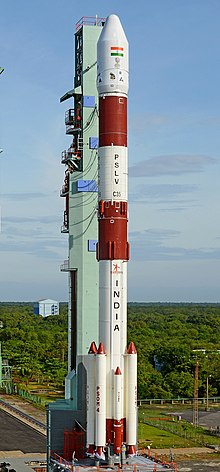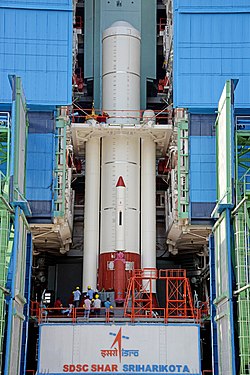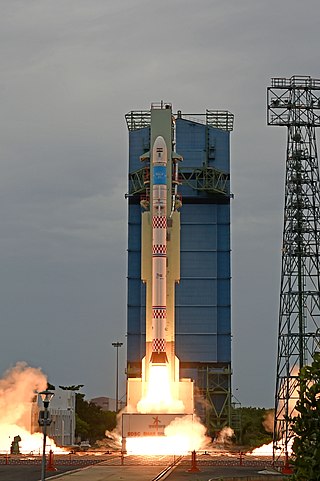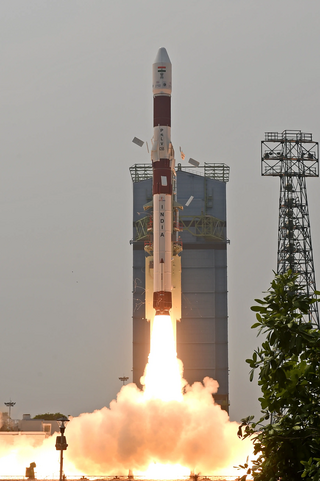 PSLV-C35 on the SDSC FLP | |
| Function | Medium-lift launch system |
|---|---|
| Manufacturer | ISRO |
| Country of origin | India |
| Cost per launch | ₹ 130 crore (equivalent to ₹153 croreorUS$19 million in 2023) - ₹ 200 crore (equivalent to ₹235 croreorUS$29 million in 2023) [1] |
| Size | |
| Height | 44 m (144 ft) |
| Diameter | 2.8 m (9 ft 2 in) |
| Mass | PSLV-G: 295,000 kg (650,000 lb) PSLV-CA: 230,000 kg (510,000 lb) PSLV-XL: 320,000 kg (710,000 lb) [2] |
| Stages | 4 |
| Capacity | |
| Payload to LEO (200 km @ 30° inclination) | |
| Mass |
|
| Payload to SSO (620 km circular) | |
| Mass |
|
| Payload to Sub-GTO (284 ×20650 km) | |
| Mass | 1,425 kg (3,142 lb) (PSLV-XL) [2] [5] |
| Payload to GTO | |
| Mass |
|
| Associated rockets | |
| Comparable | Vega,Nuri |
| Launch history | |
| Status | Active |
| Launch sites | Satish Dhawan Space Centre |
| Total launches | 60 |
| Success(es) | 57 |
| Failure(s) | 2 |
| Partial failure(s) | 1 |
| First flight |
|
| Last flight |
|
| Type of passengers/cargo | |
| Boosters (PSLV-G) –S9 | |
| No. boosters | 6 |
| Maximum thrust | 510 kN (110,000 lbf) |
| Specific impulse | 262 s (2.57 km/s) |
| Burn time | 44 s |
| Propellant | HTPB |
| Boosters (PSLV-XL/QL/DL) –S12 | |
| No. boosters | 6 (XL) 4 (QL) 2 (DL) |
| Height | 12 m (39 ft) [7] |
| Diameter | 1 m (3 ft 3 in) |
| Propellant mass | 12,200 kg (26,900 lb) each |
| Powered by | off |
| Maximum thrust | 703.5 kN (158,200 lbf) [8] |
| Total thrust | 4,221 kN (949,000 lbf) (XL) 2,814 kN (633,000 lbf) (QL) 1,407 kN (316,000 lbf) (DL) |
| Specific impulse | 262 s (2.57 km/s) |
| Burn time | 70 s |
| Propellant | HTPB |
| First stage | |
| Height | 20 m (66 ft) [7] |
| Diameter | 2.8 m (9 ft 2 in) |
| Propellant mass | 138,200 kg (304,700 lb) each [7] [2] |
| Powered by | S139 |
| Maximum thrust | 4,846.9 kN (1,089,600 lbf) [8] |
| Specific impulse | 237 s (2.32 km/s) (sea level) 269 s (2.64 km/s) (vacuum) |
| Burn time | 110 s |
| Propellant | HTPB |
| Second stage | |
| Height | 12.8 m (42 ft) [7] |
| Diameter | 2.8 m (9 ft 2 in) |
| Propellant mass | 42,000 kg (93,000 lb) each [7] |
| Powered by | 1 Vikas |
| Maximum thrust | 803.7 kN (180,700 lbf) [8] |
| Specific impulse | 293 s (2.87 km/s) |
| Burn time | 133 s |
| Propellant | N2O4/UDMH |
| Third stage | |
| Height | 3.6 m (12 ft) [7] |
| Diameter | 2 m (6 ft 7 in) |
| Propellant mass | 7,600 kg (16,800 lb) each [7] |
| Powered by | S-7 [9] |
| Maximum thrust | 250 kN (56,000 lbf) |
| Specific impulse | 295 s (2.89 km/s) |
| Burn time | 113.5 s [10] |
| Propellant | HTPB |
| Fourth stage | |
| Height | 3 m (9.8 ft) [7] |
| Diameter | 1.3 m (4 ft 3 in) |
| Propellant mass | 2,500 kg (5,500 lb) each [7] |
| Powered by | 2 x L-2-5 [9] |
| Maximum thrust | 14.66 kN (3,300 lbf) [8] |
| Specific impulse | 308 s (3.02 km/s) |
| Burn time | 525 s |
| Propellant | MMH/MON |
The Polar Satellite Launch Vehicle (PSLV) is an expendable medium-lift launch vehicle designed and operated by the Indian Space Research Organisation (ISRO). It was developed to allow India to launch its Indian Remote Sensing (IRS) satellites into Sun-synchronous orbits,a service that was,until the advent of the PSLV in 1993,only commercially available from Russia. PSLV can also launch small size satellites into Geostationary Transfer Orbit (GTO). [11]
Contents
- Development
- Vehicle description
- First stage (PS1)
- Second stage (PS2)
- Third stage (PS3)
- Fourth stage (PS4)
- Payload fairing
- Variants
- PSLV-G
- PSLV-CA
- PSLV-XL
- PSLV-DL
- PSLV-QL
- PSLV-3S (concept)
- Launch profile
- Launch statistics
- See also
- References
- External links
Some notable payloads launched by PSLV include India's first lunar probe Chandrayaan-1,India's first interplanetary mission,Mars Orbiter Mission (Mangalyaan),India's first space observatory,Astrosat and India's first Solar mission,Aditya-L1. [2]
PSLV has gained credibility as a leading provider of rideshare services for small satellites,owing to its numerous multi-satellite deployment campaigns with auxiliary payloads,usually ride-sharing along with an Indian primary payload. [12] As of June 2022,PSLV has launched 345 foreign satellites from 36 countries. [13] Most notable among these was the launch of PSLV-C37 on 15 February 2017,successfully deploying 104 satellites in Sun-synchronous orbit,tripling the previous record held by Russia for the highest number of satellites sent to space on a single launch, [14] [15] until 24 January 2021,when SpaceX launched the Transporter-1 mission on a Falcon 9 rocket carrying 143 satellites into orbit. [16]
Payloads can be integrated in tandem configuration employing a Dual Launch Adapter. [17] [18] Smaller payloads are also placed on equipment deck and customized payload adapters. [19]



















